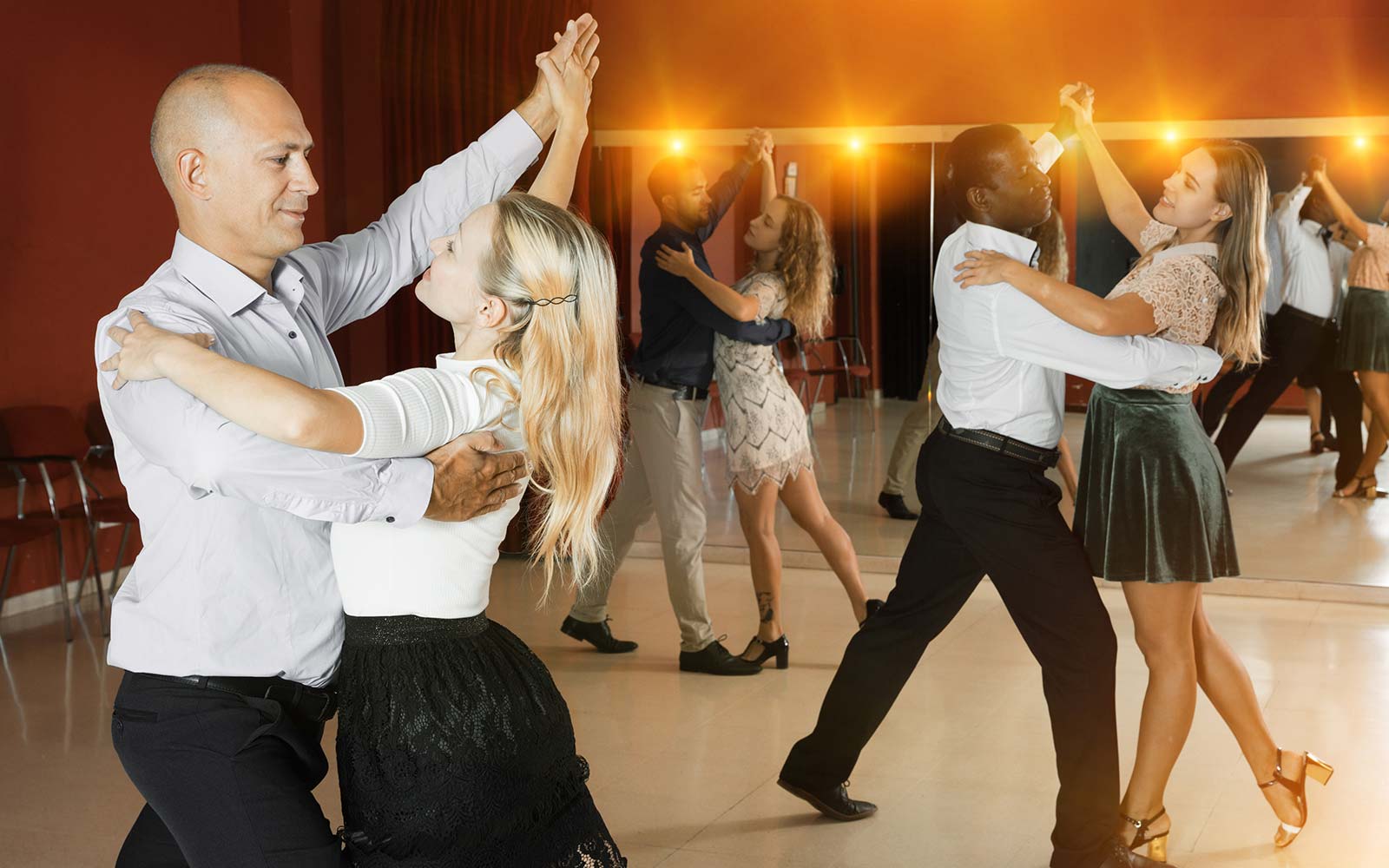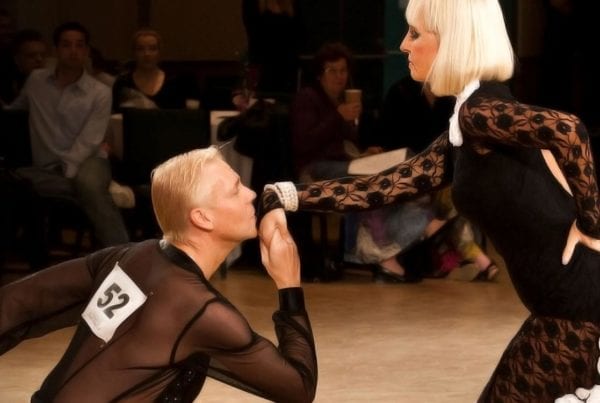I have taught or assisted in countless group classes and a great many private lessons over 12 years as a teacher. That experience has provided many opportunities to see common errors made by ballroom dancers. Here are a few of the things we see most often, along with suggestions to help you overcome them.
Common Beginner Mistakes
It can be tough for people first learning to partner dance. They are told where to put their feet, but they also have to be aware of the timing of the steps, the direction of movement, and what their partner is doing. To make it even more complicated, the partner is usually struggling as well and may be doing something that is competing with what you’re trying to do, such as moving in the wrong direction or with the wrong foot. As a result, there are many things that go wrong. Here are the most common beginner mistakes that we tend to see:
Looking Down
One of the greatest fears every man has is the fear that he will step on the lady’s foot. Seriously. It’s right up there with the fear of giving a speech. As a result, it’s pretty common for men to look down at their feet while they’re dancing. Women do it as well, but this malady affects men far more often.
Looking down destroys your posture and your confidence, not to mention the look of confidence that you’re striving to achieve as a dancer. Left unchecked, it becomes a habit that can be hard to break. It also puts a lot of extra pressure on your spine. For every inch your head comes forward as a result of a downward gaze, your spine experiences about 10 lbs of extra forward weight. That extra weight can be felt by your partner because the head weight moves into the center of the partnership, causing numerous challenges with the overall movement. By looking down, your forward movement will come from the upper body instead of from the center of gravity.
When dancing, always keep your head aligned with your spine. It helps to look slightly above the heads of people who might be standing around the dance floor. This will usually put the angle of your head in the right place.
Looking down is not just a beginner mistake, either. Seasoned dancers can also be guilty of casting their eyes downward, even if the head is straight. They might be watching the space on the floor in order to manage floor craft, or they might be thinking too much. The result will also be a look of uncertainty and lack of presence.
Failure to Close the Feet
Many dances have a requirement to “close” the feet. This is a technical term that means bringing the feet together and immediately changing weight to the foot that just moved. When you miss that action, you will end up using the same foot again, which puts you out of alignment with your partner’s foot. And that is when partners step on each other!
This is probably the most common mistake beginners make in the Waltz in particular. Learning to close the feet properly makes it significantly easier to learn the dance. But if you fail to change weight, then the Waltz becomes a challenge, because the feet close generally on every third step.
If this is something you’re struggling with, try this exercise to train your feet: march the box step. You won’t dance it like that, but if you lift the feet and march the steps like a soldier, you’ll train your feet to be in the right place at the right time and they will automatically change feet. Once that becomes part of your muscle memory, you’ll find it easy to do it with regular foot movement.
Not Finishing the Figures
Another common beginner mistake happens when the lead is busy thinking about the next figure and leads into it before finishing the figure he is currently on. No matter what dance you are performing, leading before the figure is done causes confusion for your partner and usually puts you on the wrong foot to even start the next figure.
If this happens to you, try using very slow practice music, or pausing between figures as an exercise to give you thinking time so that you are only performing one figure at a time instead of blending them all together. Eventually you’ll get comfortable with the way the patterns fit together and can start dancing without that pause.
Intermediate-Level Mistakes
No dancer is perfect. We all make mistakes. So even if you’re an experienced dancer, accept the fact that there is room for improvement in many areas. Even world champions continue to train regularly to improve their dancing!
No CBM
Probably the most common error we see among seasoned dancers is not realizing the importance of Contra Body Movement, or CBM. Every dance requires it in virtually every figure, usually many times in the pattern. The official definition is “moving the opposite side of the body toward the moving leg.” CBM is in reality a reflection of normal walking movement. When we step forward with our right foot in a walk, our left arm comes forward. It’s natural! But somehow, when people dance, they keep their bodies rigidly facing forward or backward even if they are turning, resulting in rotation that happens much too late to be useful.
Not only does CBM assist in movement and rotation, it also communicates valuable information to the Follow, making it easy for her to respond to the rotation properly.
Solving this problem can be difficult, because there’s no easy fix other than doing it. I hesitate telling people to turn their shoulders, because this leads to another mistake. It’s actually your center that rotates, not your shoulders. But it might help as an exercise to think about the shoulders turning into the direction of rotation as the figure begins, in order to train you to add CBM to your movement.
Improper Use of Heels and Toes
Although it isn’t as common, we do see experienced social dancers who don’t use the heels and toes correctly when moving forward. Most often it’s actually the ladies who are guilty of sliding the ball of their foot forward instead of using the heel. Admittedly, I’ve never tried dancing in women’s shoes. It can’t be easy creating strong dance movement stepping onto those narrow 2-inch heels, but using only the ball of the foot robs you of quality movement.
Men more often mess up in the Waltz Chasse or in the Quickstep Lock, where they use their heel on the last step of the figure instead of using their toe. This is usually the result of having your weight too far forward over the leg instead of letting the leg get out in front of you. I’ll cover weight transfer momentarily.
It can’t be easy creating strong dance movement stepping onto those narrow 2-inch heels, but using only the ball of the foot robs you of quality movement.
The basic rule in the Ballroom dances is that if you are down low, you use the heel to move forward, and if you are up you use the toe for your next step. To fix the problem of using the toe to move forward, try lowering more and sending the leg to extend out in front of you more. It will naturally allow the foot to roll onto the heel as the leg extends. To fix the problem of using the heel at the end of the Chasse, try keeping your body weight back over the standing leg as you take that fourth step, instead of moving your body forward with the leg.
Falling Into Steps
In the Ballroom genre, all the Swing dances (Waltz, Slow Foxtrot and Quickstep) have figures where the direction of movement changes. For example, the Outside Change in Waltz, the Telemark, and the V6 in Quickstep. In these figures the movement goes up on the toes, and then changes direction. Perhaps the most common mistake we see in each of these cases is that either partner (usually the lady) falls into the next step after the directional change. This is the result of the body weight being too far back as she starts her back step. No matter how strong your ankles, if your entire body weight is over that foot when it moves, you will not be able to avoid falling onto that foot instead of softly arriving onto the toe and slowly lowering the heel.
Most seasoned ladies are aware of the need to have a stretch of their body diagonally away from and to the right of their partner (to their own left). Unfortunately, they often misunderstand how that stretch is achieved and simply lean their body and head back. This will always cause their body weight to be aligned over the back foot and lead to this kind of mistake when changing direction from forward to back. Instead, remember to project your energy upward through the rib cage. This will enable to you to balance your weight over the front foot as you perform these figures, allowing you to control the change of direction elegantly.
Leading with the Arms
You might think this is only a beginner mistake, but sadly it’s very common even among seasoned social dancers. With the arm held out to the man’s left side in the Ballroom dances, and in front of you for many figures in the Latin and Rhythm dances, it can be pretty easy to use arm to lead even without realizing it. Wendy has encountered seasoned competitors who will use the arm, or worse, squeeze the connecing hand, to create a lead. Men will often push their left arm forward or sideways to create a lead, or they will create an awkward stirring-the-pot action to lead an underarm turn, as if the lady is incapable of turning herself.
In the Ballroom genre, the man’s elbow line creates his frame. When a man leads with his arms, he destroys his frame and puts the lady out of balance. The frame should be mostly undisturbed throughout the dance. Leads happen not through the arm but through the center of the body. When you lead an underarm turn, you should simply lift the hand, nothing more. You don’t need to “help” the lady with her turn! All that does is throw her off her own balance.
Improper Weight Transfer
You’ll actually spend the rest of your life working on the skill of improving weight transfer from foot to foot. This is where the real skill of ballroom dancing — indeed, all dancing — comes into play. Much of what makes you admire the quality of a couple as compared to others is related to their ability to properly manage their weight transfer. This affects the power of movement, posture, connection of the couple, and musicality. So, it’s not surprising that improper weight transfer is the source of many problems in dance.
Different dances have different requirements for the timing and technique for transfering weight. Slow Foxtrot is dramatically different from the way we transfer weight in Tango, and that is dramatically different again from weight transfer in Quickstep. If we are moving backwards and place our body weight too far back, it literally pulls your partner off their feet. Likewise, if you transfer your weight too quickly to the side on a sideways step, your upper body momentum will want to keep going past the foot, causing you to need muscular action to control it. This makes the dance hard work, filled with unnecessary effort.
Since every dance has different requirements, I can’t go into a lot of detail here to help you fix it. But I can suggest that you work to let the leg go out before the body gets there, rather than taking the body with the leg. This is almost always going to help you manage the transfer of weight.
There are, of course, a great many mistakes that haven’t been mentioned here. But these are the ones we see almost every class. If you recognize yourself in any of these areas, make an effort to resolve the issue to greatly improve your dancing.














